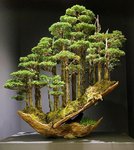Mike Corazzi
Masterpiece
Yep, I know I will violate every aesthetic rule for bonsai but I have some olive seedlings that have lived through being unceremoniously jammed into ...dirt... from some cuttings.
Some are interesting. All look like a neglected orchard.
So....penjing or blasphemy, I think they'd look dandy as a neglected olive orchard hillside.
Any ideas other than tarring and feathering?
Some are interesting. All look like a neglected orchard.
So....penjing or blasphemy, I think they'd look dandy as a neglected olive orchard hillside.
Any ideas other than tarring and feathering?



 525751e5-fef1-48af-95ae-9e8c5f59023c
525751e5-fef1-48af-95ae-9e8c5f59023c afde8308-5923-4e16-84e9-f41ee35291a8
afde8308-5923-4e16-84e9-f41ee35291a8 b293cdb3-8787-4233-8afd-198e3360391f
b293cdb3-8787-4233-8afd-198e3360391f